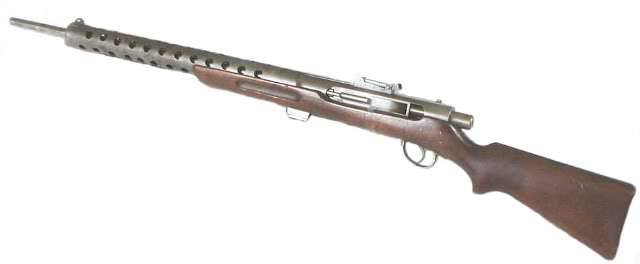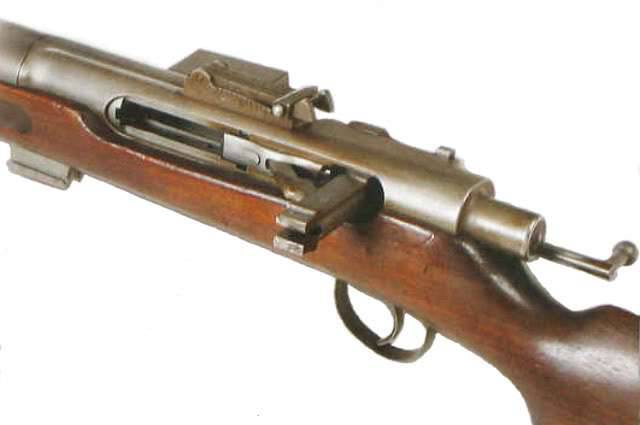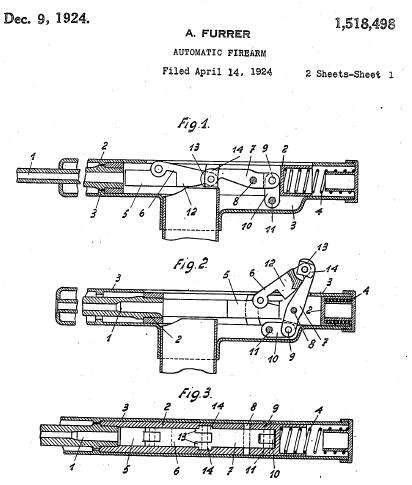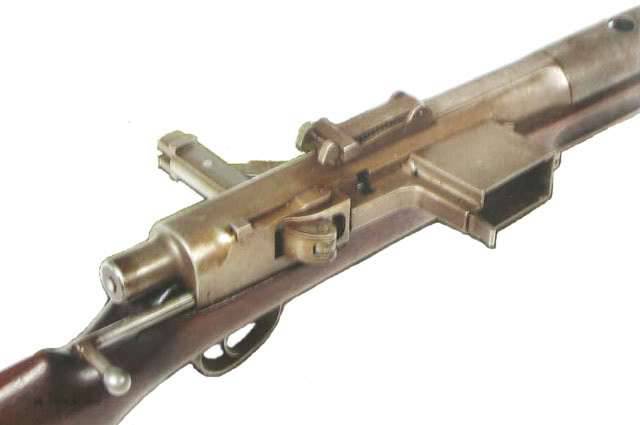Automatic carbine W + F M1921 (Switzerland)
February 15 20168
Until a certain time, Switzerland fell behind with the development of submachine guns, but in the early twenties a real breakthrough was made: the first Swiss intermediate cartridge was created weapon under it. Thus, the Swiss gunsmiths could claim primacy in the creation of assault rifles or assault rifles. However, for various reasons, these weapons did not go into the series and filled up a sad list of promising, but unpromising projects.
Having failed with the design of the machine gun M1919, employees of the Bern factory W + F (Waffenfabrik), led by Colonel Adolf Furrer, continued to work on the new weapon. Apparently, they considered the relatively weak pistol cartridge 7,65x21 mm Parabellum to be one of the main problems of their previous development. To replace this ammunition was developed a new cartridge increased power. This cartridge has received an enlarged sleeve length of 35 mm and a greater charge of gunpowder. It was assumed that the power of the ammunition would be inferior rifle, but significantly surpass the existing pistol, such as the previously used 7,65-mm cartridge Georg Luger.
The new cartridge was proposed to be used with the new weapon. Due to the specificity of the cartridge, this weapon was originally given the symbol Pistolengewehr - “Pistol-rifle”, because it had to combine the features of both these classes of weapons. Thus, the ammunition 7,65x35 mm designed by A. Furrer can be considered one of the first samples of the intermediate cartridge, and the “Pistol-rifle”, with some reservations, should be included in the list of early automata.

General view of the M1921 carbine
According to some sources, the 7,65x35 mm cartridge was only the first version of the new ammunition. Soon after it was tested at the test site, an 7,5x37 mm cartridge was developed, distinguished by a modified bullet and a different sleeve. Thus, at an early stage of development, a promising weapon was intended for the use of an 7,65-mm cartridge, and then it was altered to make an ammunition 7,5x37 mm.
Due to the classification features of small arms, the Pistolengewehr of the W + F factory is almost never called automatic. More often, these weapons are classified as automatic rifles or automatic rifles. In addition, instead of the name “Pistol-rifle”, the designation M1921 is used, which designates the year of creation of the weapon. There is also the M1920 index, which, according to some sources, wore an early draft of a weapon chambered for 7,65x35 mm. After the transition to the cartridge 7,5х37 mm, the designation M1921 appeared.
The M1921 carbine project was a logical continuation of the previous development. It was proposed to take the M1919 submachine gun as a basis and change its design in connection with the use of a completely new cartridge. In addition, some other changes should be made to improve performance, improve ergonomics, etc. The result was a weapon that was only partially similar to its predecessor, but widely using its main ideas.
In the new weapon, it was again decided to use automation based on recoil of the barrel with the bolt locked using a lever mechanism similar to that used in the Parabellum pistol. Thus, with the exception of the size and configuration of some parts, the automatics of the new carbine practically repeated the aggregates of a submachine gun that was not approved by the army. It should be noted that A. Furrer’s zeal in promoting his ideas, despite the refusals of potential customers.
The main part of the M1921 automatic carbine was an oblong tubular receiver. In its front part, which served as the casing of the barrel, there were round holes for ventilation. The rear part contained the main parts of automation, and also had several cuts and additional parts on the surface. Inside the box, the barrel was movably mounted, connected to the gate retaining part and its lever system. Behind this unit was tightened by a return spring.

Mechanisms of automation. Backseat shutter, arms folded together
On the left surface of the receiver, a large oblong window was provided for the exit of the movable levers of the bolt and the ejection of the spent cartridges. On the opposite side of the weapon there was a small receiving shaft of the store, behind which there was a window for the withdrawal of levers. Behind the bottom in the tubular receiver were mounting for the firing mechanism.
The main elements of automatic weapons were a movable barrel held in the forward position by a return spring, a bolt and three levers. In addition, the mechanisms involved several shaped grooves on the inner surface of the receiver. The system of the bolt and the three levers repeated the same block of the M1919 submachine gun and had some differences from the G. Luger pistol, taken as a basis. In its composition there were not two, but three levers. During the shot, two long levers were arranged parallel to the barrel, and a short rear lever connecting the second long lever and the box was perpendicular. In the course of work, the levers had to change their position.
Under the effect of recoil shot, the barrel had to roll back, compressing the return spring. In this case, the levers with the help of protrusions on the surface interacted with the grooves of the receiver and began to move. With the rearmost position of the bolt, the small lever rotated parallel to the barrel, and the rear large one - perpendicular. Further, under the action of the return spring, the barrel returned to the forward position, and the levers were also placed in the initial position with the feed of the bolt forward. For the initial cocking mechanisms used L-shaped thrust connected to the bolt and derived through the hole in the rear wall of the receiver.
As in the previous project, A. Furrer decided to equip the weapon with a side magazine. According to his idea, the cartridges should have come to the bolt on the right, and the spent cartridges should be thrown to the left. For ammunition weapons offered detachable box stores on 30 “intermediate” cartridges.

The principle of operation of the system of levers and shutter
The trigger mechanism of an automatic rifle was controlled by a traditional trigger. Information about the modes of operation of USM vary. In some sources, the possibility of firing single or in bursts is mentioned, in others, only solitary fire from a samovzvod. Also, there is no accurate data on the design and principle of operation of the fuse.
Perspective carbine was equipped with a wooden lodge rifle type. In its front of the cutout was provided for mounting the receiver with mechanisms, there was a butt in the back. For the convenience of holding the weapon in front of the butt there was a neck with a pistol protrusion. In front of the box, in front of the barrel chamber, it was proposed to install a bipod mount or an additional support similar to that used on the M1919 submachine gun. With the help of such a device it was possible to fire with greater accuracy.
In order to simplify production, the M1921 automatic rifle “inherited” ready aiming devices. The front sight and the open sight were borrowed from one of the series rifles that were used by the Swiss army. The fly was located above the front end of the barrel housing, and the sight was attached over the automation mechanisms.
In terms of size and weight, the carbine was almost the same as the models already in service. Its length reached 1,15 m, and the weight without cartridges was 5,6 kg. When using additional support, the mass of weapons should have grown. At the same time, the usability could have deteriorated since a device with a length of 260-380 mm appeared under the bed.
According to some reports, using a relatively long barrel automatic rifle could provide the initial speed of the bullet at the level of 600-610 m / s. Sample rate is unknown. The effective firing range is of the order of 100-200 m.

View of the node automation from the store. One can see a window with protruding levers
In preparation for testing the new weapons and for the possible order from the army, the W + F factory initiated the production of promising “intermediate” cartridges. Due to the lack of necessary production capacity, the factory ordered such ammunition to the MFT factory. From November 1921 to February 1923 of the year, 27 thousand new rounds of ammunition rolled off the conveyor of this enterprise. More production of such ammunition was not conducted. It should be noted that as part of one of the following projects in 1933, 650 cartridges were completed, the purpose of which was to change the characteristics and study this version of the munition.
In the 1921-22 years, A. Furrer offered the military his new development. Experienced “rifles” passed tests, but did not interest the army. According to available data, the used cartridge became the main reason for the refusal to continue the work and put it into service. At the beginning of the twenties, there was still no complete understanding of the prospects for ammunition, which was intermediate between pistol and rifle weapons. Thus, the Pistolengewehr M1921 product did not correspond to the existing range of ammunition and the views of the military. The project was closed due to the lack of prospects.
According to various sources, several prototypes of the new automatic carbine were made. It is known that at least one prototype in the next few decades was kept in museums and private collections, changing the host from time to time.
The time of weapons under the intermediate cartridge has not yet come. The Swiss military still wanted systems designed to use rifle cartridges. Using the existing developments, A. Furrer continued to create new types of weapons. The result of his work in the near future was the new machine gun, which managed to stay in the ranks for several decades.